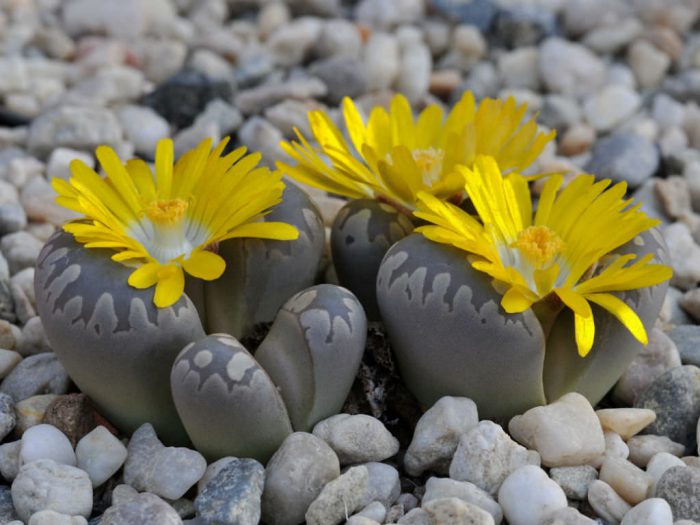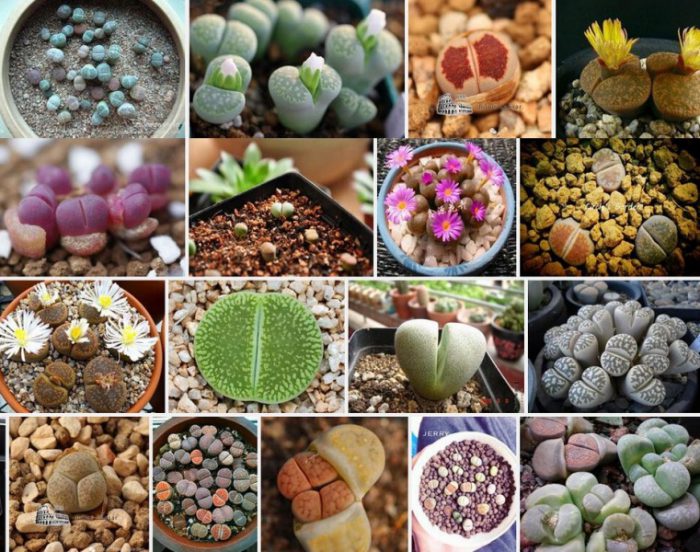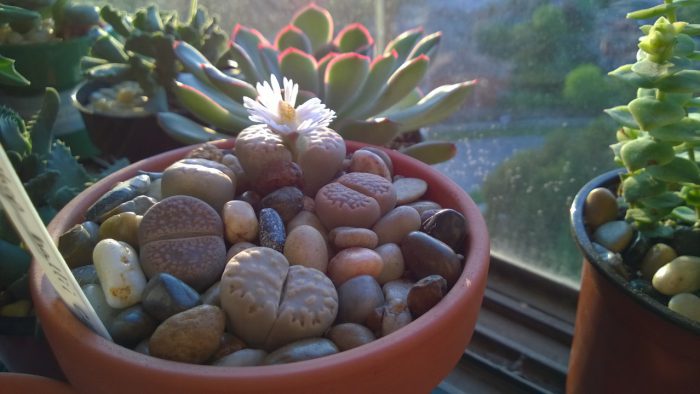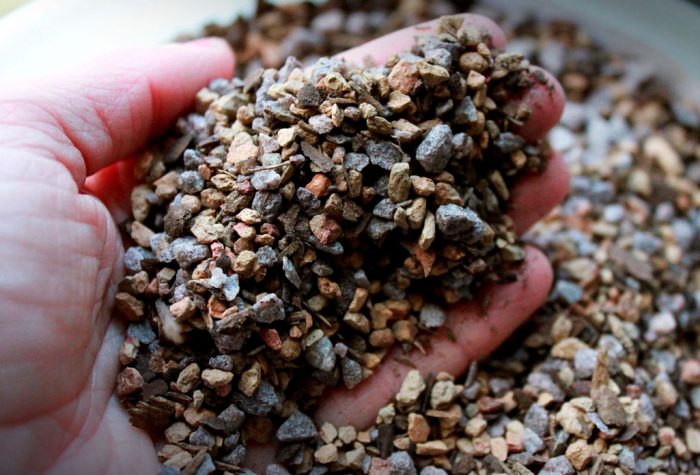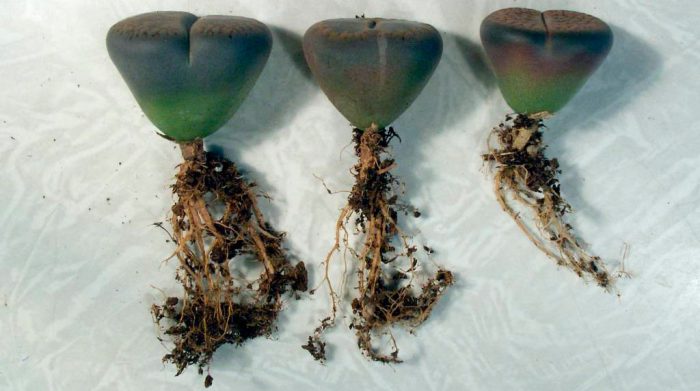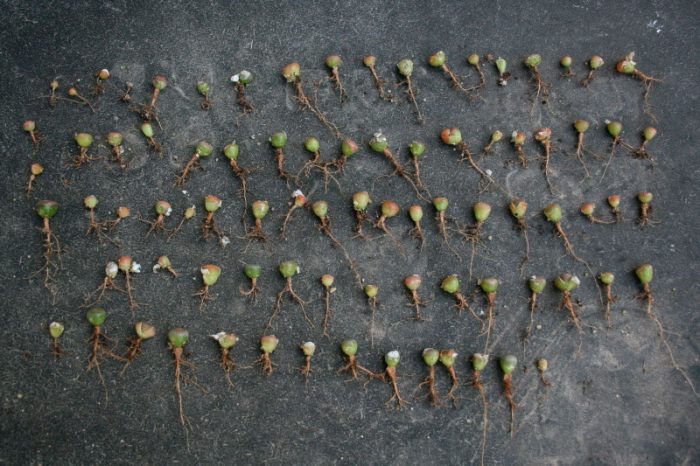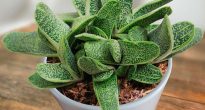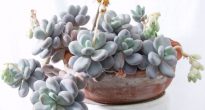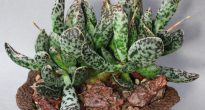Succulent plants such as lithops also called "living stones". Under natural conditions, these not quite ordinary plants grow in stony deserts, and they can be easily confused with pebbles, since they are small, round in shape, and the color repeats the color of the soil on which they grow. And the most interesting thing is that these plants are flowering. But do lithops grow indoors?
The genus Lithops (Lithops) is directly related to the family of mesembriantemic or Aizovye (Aizoaceae). Today, 37 species of this genus are known (some of the species are divided into subspecies). It is sometimes very difficult to determine exactly which species a particular plant belongs to, because its color and some other features are very changeable, and directly depend on the habitat.
Under natural conditions, lithops can be found in the rocky deserts of Southwest and South Africa. They are able to grow even in places where other plants do not survive. The plant is able to easily tolerate huge temperature changes. So, in its habitats, most often in the daytime the temperature rises to 50 degrees, and at night it is very cold there. These plants prefer to grow on scree, on granite chips, on the southern slopes, on very hard clayey soil.
The color of lithops is very different and it can change depending on the color shade of the soil. So, the color of the leaves ranges from brown or even purple to green or gray. The plant has a pair of fleshy leaves, which can be either flat or convex. Often on their surface you can see various patterns, as well as spots, and almost every species has its own.
The opened flowers are rather large (2 to 4 centimeters in diameter), which, as a rule, exceeds the size of the lithops itself. The blossoming flower withers only after 10 days. Most often, in spring, 2 new leaves grow to replace the old ones.
You can easily grow these not quite ordinary "living stones" at home. You need to take care of them in almost the same way as for cacti. However, experienced flower growers do not recommend planting lithops in separate pots, and it is better to plant them in not very large groups.
Content
Lithops care at home
The main thing to remember is:
- the land must be poor, rocky and permeable;
- you need systematic ventilation;
- choose a solar window for lithops;
- poor watering.
Those who are engaged in the cultivation of exotic plants recommend planting other succulents in the lithops pot, but in no case should they suppress the growth of "living stones". These plants must grow very slowly and need little watering. So, for these purposes, cacti, euphorbia (not all), plants belonging to the asphodelic family (Gasteria, Haworthia) or to the Aiz family (faucaria, conophytum, delosperm) are suitable.
This planting of different plants in one pot is very useful for lithops, since when overflowing, excess moisture can easily absorb milkweed or cacti.
Seat selection
Considering that in the desert, where lithops grow, it is always very sunny, then you can easily decide on the choice of a place for growing indoors. So, the window sill located in the southern part of the room is perfect for them. It is not recommended to unfold the flowerpot, as a constant orientation to the sun is an important condition during bud setting.
Temperature regime
It tolerates high temperatures relatively easily. In the summer, the best temperature for this plant is in the range from 22 to 25 degrees, and during the rest period - from 12 to 15 degrees (do not let the temperature drop below 5-7 degrees). It happens that on hot summer days, lithops overheat in the southern window. The fact is that in the wild, the root system of such a plant penetrates very deep into the soil, where it is cool enough. And being in the sun in a small pot, its roots can overheat.
How to water
Watering is carried out during intensive growth and is done 2 times a month. During the dormant period, which lasts from January to March, it does not need to be watered. In the case when the room is very warm and dry, lithops can be watered (no more than 1 time in 4 weeks).
After the buds are laid, the plant should not be watered.
This plant easily tolerates overdrying of the soil, but reacts extremely negatively to overflow. In the event that the soil is wet for a long time, the "living stone" rots. But you will not find out about this right away, since at first it looks quite normal, and then it shrivels and dries up sharply.
Proper watering is very important for this plant. It should be rare and abundant. After you water the plant, the substrate, along with the roots, should be completely wet. However, the excess liquid must leave the pot very quickly. The moisture remaining in the sand and on the pebbles is enough for the plant.
Some growers believe that during watering, you should not allow liquid to get on the lithops foliage. However, it is not. Water that gets on the leaves can harm the plant only if it is in the sun (it will cause burns). The fact is that in natural conditions such "pebbles" are found on the rocks located near the sea coast, and there are quite often strong fogs at night.
Earth mix
You need water and breathable earth. To create a suitable soil mixture, deciduous soil is mixed with brick chips (red), coarse sand, small pebbles and granite chips.
The soil mixture is used poor, therefore it should contain a fairly large amount of sand. Don't forget to make a layer of small stones both at the bottom of the pot and on the top of the soil. At the bottom, such stones act as a drainage layer, and on the surface of the earth, they prevent the appearance of rot on the root collar, as they provide good ventilation.
Humidity
They feel great in low air humidity. Lithops should not be sprayed, but they need regular ventilation, otherwise rot may form.
Top dressing
For 12 months after the plant has been transplanted, it should not be fed. Then he is fed from June to September 1 time in 4 weeks, using fertilizer for cacti (1/2 of the recommended dose), but this is if there were no new transplants.
Features of the rest period
The dormant period begins in late autumn after flowering ends and lasts until spring. The plant does not need watering at this time. Lithops should be placed in a dry and sunny place for this period. When the plant begins to grow again (the dormant period ends), watering is resumed, but this should happen gradually. Old yellowed leaves that have lost their turgor “slide” down, and young ones appear in their place. It is not recommended to remove old leaves on your own, even if they are very dry.
How to transplant
The transplant is carried out only in case of emergency, for example, when the pot becomes small for lithops. The roots grow back rather quickly, filling the pot completely. Thin roots can be damaged during transplantation, since they grow back easily and quickly, but it is not recommended to touch the thick root.
A flower pot should be chosen deep enough (at least 10 centimeters in height), since the roots of "living stones" in natural conditions grow in depth. Low but wide planting containers should not be used.
Reproduction methods
Can be propagated by seeds. The seeds appear after flowering and look like small fruits. After sowing, they are placed in a warm place (from 22 to 25 degrees). You can try to buy a change online from an exotic plant grower. You can also propagate by young shoots, separated from the old plant.
The resulting pods should be left on the lithops until young leaves grow. Then they are collected and placed in a dark, dry place for 4-6 months. Then they can be sown. Before sowing, the seeds must be immersed in water for 3–6 hours. And after sowing, the pot is covered with glass. Regular spraying and airing of crops is necessary. Make sure that the temperature is not below 25-28 degrees during the day. The pick is carried out 1 year after the emergence of shoots, and they do it in early spring.
Pests
In winter, a worm may start. In this regard, with the beginning of active growth, lithops should be treated with a protective agent.

